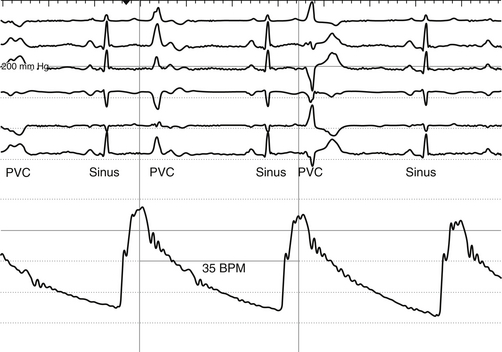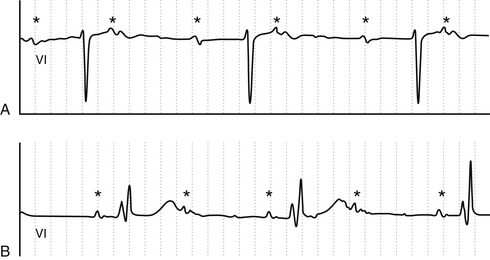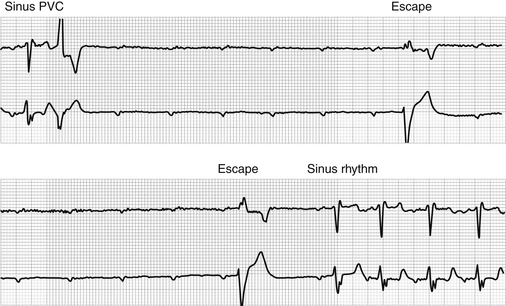Chapter 33
Arrhythmias (Bradycardias)
Bradyarrhythmias, or slow heart rhythms, occur commonly in patients treated in the intensive care unit (ICU). Assessment of the critically ill patient with a bradyarrhythmia needs to take into account the clinical context and whether or not the bradyarrhythmia is causing either significant symptoms or hemodynamic compromise. Bradyarrhythmias may reflect physiologic (e.g., high vagal tone) or pathologic (e.g., high grade conduction system disease) conditions. Usually these arrhythmias resolve spontaneously or after treating the underlying cause. However, rarely, either temporary (such as a temporary pacing wire or chronotropically stimulating drugs) or permanent (such as a permanent pacemaker) interventions may be required. This chapter provides a concise approach to the ICU patient presenting with bradyarrhythmias. Bradyarrhythmias in the setting of acute myocardial infarctions are discussed in Chapter 50.
Approach to the Patient Presenting with a Bradyarrhythmia
In terms of diagnosing the mechanism, or the underlying disturbance in the conduction system leading to the bradyarrhythmia, all available resources in the ICU for documenting and reviewing the rhythm should be used. The primary ways in which the heart rate and rhythm are recorded in the ICU include pulse checks and telemetry. The limitations of each and alternative methods of diagnosing the electrophysiologic mechanism of the arrhythmia need to be considered in order to optimize decision making. In the case of pulse checks, the recorded heart rate while palpating the radial, femoral, or carotid pulse may not always reflect the number of times the heart is electrically depolarizing. For example, frequent nonperfused premature ventricular contractions may result in a QRS complex on telemetry or electrocardiography that is not noted while palpating the pulse (Figure 33.1). Thus, a pulse check in the absence of corresponding telemetry may be ineffective in establishing the diagnosis of a bradyarrhythmia in the absence of corresponding electrocardiogram (ECG) recordings.
In some patients, because of inability to adequately see atrial activity on the limited leads available on telemetry or because of noise on telemetry that may impede interpretation, a full 12-lead ECG may be needed to diagnose the mechanism of the bradyarrhythmia. However, telemetry is generally sufficient to identify and diagnose the arrhythmia mechanism.
Classification of Bradyarrhythmias
Sinus Node Dysfunction
Causes of sinus node dysfunction in ICU patients are listed in Box 33.1. It is important to recognize that sinus bradycardia is commonly seen in young athletic patients, during sleep, and during conditions associated with high vagal tone (pain, nausea, vomiting, endotracheal manipulation, bowel movements). These episodes are almost uniformly transient and asymptomatic. Treatment should be considered only if the bradycardia persists, is symptomatic, or results in hemodynamic compromise and the underlying cause is expected to recur or cannot be withdrawn.
Sinus node dysfunction, particularly in the elderly, may also be associated with tachycardia-bradycardia syndrome in which symptoms may be related to the tachy- or bradyarrhythmia. Tachycardia-bradycardia syndrome is characterized by periods of atrial tachyarrhythmias (atrial flutter, atrial tachycardia, or atrial fibrillation [see Chapter 34]) interspersed with periods of sinus bradycardia or sinus arrest. Tachycardia-bradycardia syndrome is most often seen in the setting of paroxysmal atrial fibrillation when a prolonged sinus recovery time upon termination of the atrial fibrillation episode may lead to a sinus pause (“offset pause”) or a period of sinus bradycardia. Rarely, these pauses may result in syncope. Because symptoms can be due to either tachycardia or bradycardia, treatment consisting of both medication to control the fast heart rates and permanent pacing to prevent slow heart rates may be required in these patients.
Atrioventricular Conduction Disturbances
Disturbances of propagation of electrical impulses from the atria to the ventricles are classified as being secondary to different degrees of atrioventricular (AV) block (first, second, or third degree). This classification is based on the electrocardiographic pattern of the conduction disturbance which, in turn, is used to correlate with the anatomic substrate. Block occurring in the AV node generally signifies a more benign prognosis than does block resulting from disease of infranodal structures (e.g., the His-Purkinje system). Although intrinsic cardiac disease can lead to AV conduction disturbances, reversible extrinsic causes should be sought before interventions are considered (see Box 33.1). Depending on how readily the extrinsic cause may be reversed, temporary interventions to treat the bradyarrhythmia may be required. Except in cases of higher-grade conduction block at high risk of progressing to complete heart block or asystole (discussed later), acute intervention (pharmacologic or pacing) should generally be reserved for patients who are symptomatic or hemodynamically compromised. The anatomic site of block is relevant in defining which patients should receive a permanent pacemaker. However, the ultimate decision on the need for treatment is based on the presence of symptoms attributable to the bradyarrhythmia.
First-Degree Atrioventricular Block
First-degree AV block, defined as a PR interval > 200 milliseconds, rarely results in symptoms or significant hemodynamic compromise. It is most often due to delay of the electrical impulse as it traverses the AV node. Disease of the His-Purkinje system can occasionally prolong the PR interval, though generally its contribution to the PR interval is negligible. Because every impulse originating in the sinus node propagates to the ventricle, first-degree AV delay is a more accurate description of this phenomenon.
Second-Degree Atrioventricular Block
Second-degree AV block is divided into Mobitz I block (Wenckebach) and Mobitz II block. Mobitz I block is characterized as progressive prolongation of the PR interval until a P wave fails to propagate to the ventricle (Figure 33.2). Because the incremental PR prolongation decreases with each consecutive beat, the RR intervals progressively shorten during Mobitz I block. Generally, the simplest mechanism by which to diagnose Mobitz I block is to compare the PR interval of the beat conducted immediately after the skipped beat with the PR interval of the beat conducted immediately before the skipped beat, as successive PR intervals may only show gradual prolongation. The presence of Mobitz I block generally indicates that the site of block is in the AV node, thus portending a more benign prognosis. However, Mobitz I block can rarely occur in the infranodal structures, though intracardiac recordings are required for this diagnosis. Permanent pacemaker implantation is indicated only in patients in whom Wenckebach block has been demonstrated to cause symptoms.
Mobitz II block is defined as the sudden failure of conduction of an impulse from the atria to the ventricles and manifests on the ECG as unexpected block of a P wave without the progressive prolongation of the PR interval seen with preceding beats (Figure 33.3). Mobitz II block signifies infranodal disease and often is associated with other electrocardiographic signs of conduction system disease (e.g., bundle branch block or intraventricular conduction delays). Although a permanent pacemaker may not be absolutely indicated for patients with asymptomatic Mobitz II block, there is a risk of a sudden loss of atrioventricular conduction and, if this happens, a ventricular escape rhythm may or may not be present. Thus, the majority of patients do receive pacemakers given the relatively high risk (40% to 80%) of progression to higher-grade AV block. In particularly high-risk patients, a temporary pacing wire may be appropriate until a permanent pacemaker can be implanted.
Patients with 2:1 AV block, in whom every other P wave is associated with a QRS complex, may be difficult to classify as either Mobitz I or II block because there is no opportunity for the PR interval to become prolonged with successive beats (Figure 33.4). The site of block in these patients may be either AV nodal or infranodal. Clues on the ECG that suggest an infranodal site include a wide QRS (> 120 msec) on the conducted beats or an associated bundle branch or fascicular block. Furthermore, a normal PR interval on the conducted beats may support the presence of infranodal disease. In these patients, the effective heart rate (defined by the ventricular rate) is half that of the atrial rate. Findings suggestive of infranodal disease or the presence of associated symptoms should prompt consideration of placement of a temporary pacemaker and, ultimately, a permanent pacemaker in those without a definite reversible cause.
Third-Degree Heart Block
One example of transient complete heart block that should prompt immediate referral for either a temporary pacemaker or, if readily available, a permanent pacemaker is the presence of phase 4 block, or bradycardia-dependent block. In this form of block, an atrial, junctional, or ventricular extrasystole may precipitate a period in which there is complete loss of conduction of atrial stimuli to the ventricle. This appears on the ECG as a series of P waves without associated QRS complexes (Figure 33.5). The mechanism of block is poorly understood but involves fluctuations in phase 4 of the action potential associated with changes in the frequency of electrical stimuli reaching the His bundle. The onset of heart block resulting from extrasystoles is unpredictable, and thus a single episode of phase 4 block should immediately prompt referral for either the placement of prophylactic transcutaneous pads in case of a recurrent episode or placement of a transvenous pacing wire until a permanent pacemaker can be placed.
< div class='tao-gold-member'>

Full access? Get Clinical Tree








